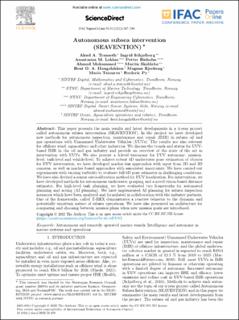| dc.contributor.author | Transeth, Aksel Andreas | |
| dc.contributor.author | Schjølberg, Ingrid | |
| dc.contributor.author | Lekkas, Anastasios | |
| dc.contributor.author | Risholm, Petter | |
| dc.contributor.author | Mohammed, Ahmed Kedir | |
| dc.contributor.author | Skaldebø, Martin Breivik | |
| dc.contributor.author | Haugaløkken, Bent Oddvar Arnesen | |
| dc.contributor.author | Bjerkeng, Magnus Christian | |
| dc.contributor.author | Tsiourva, Maria Efstathia | |
| dc.contributor.author | Py, Frédéric | |
| dc.date.accessioned | 2023-06-19T09:01:51Z | |
| dc.date.available | 2023-06-19T09:01:51Z | |
| dc.date.created | 2022-12-22T10:39:49Z | |
| dc.date.issued | 2022 | |
| dc.identifier.citation | IFAC-PapersOnLine. 2022, 55 (31), 387-394. | en_US |
| dc.identifier.issn | 2405-8963 | |
| dc.identifier.uri | https://hdl.handle.net/11250/3072008 | |
| dc.description.abstract | This paper presents the main results and latest developments in a 4-year project called autonomous subsea intervention (SEAVENTION). In the project we have developed new methods for autonomous inspection, maintenance and repair (IMR) in subsea oil and gas operations with Unmanned Underwater Vehicles (UUVs). The results are also relevant for offshore wind, aquaculture and other industries. We discuss the trends and status for UUV-based IMR in the oil and gas industry and provide an overview of the state of the art in intervention with UUVs. We also present a 3-level taxonomy for UUV autonomy: mission-level, task-level and vehicle-level. To achieve robust 6D underwater pose estimation of objects for UUV intervention, we have developed marker-less approaches with input from 2D and 3D cameras, as well as marker-based approaches with associated uncertainty. We have carried out experiments with varying turbidity to evaluate full 6D pose estimates in challenging conditions. We have also devised a sensor autocalibration method for UUV localization. For intervention, we have developed methods for autonomous underwater grasping and a novel vision-based distance estimator. For high-level task planning, we have evaluated two frameworks for automated planning and acting (AI planning). We have implemented AI planning for subsea inspection scenarios which have been analyzed and formulated in collaboration with the industry partners. One of the frameworks, called T-REX demonstrates a reactive behavior to the dynamic and potentially uncertain nature of subsea operations. We have also presented an architecture for comparing and choosing between mission plans when new mission goals are introduced. | en_US |
| dc.language.iso | eng | en_US |
| dc.publisher | Elsevier | en_US |
| dc.rights | Attribution-NonCommercial-NoDerivatives 4.0 Internasjonal | * |
| dc.rights.uri | http://creativecommons.org/licenses/by-nc-nd/4.0/deed.no | * |
| dc.subject | Marine vessels | en_US |
| dc.subject | Marine operations | en_US |
| dc.subject | Autonomy | en_US |
| dc.subject | Autonomous subsea intervention | en_US |
| dc.title | Autonomous subsea intervention (SEAVENTION) | en_US |
| dc.title.alternative | Autonomous subsea intervention (SEAVENTION) | en_US |
| dc.type | Journal article | en_US |
| dc.type | Peer reviewed | en_US |
| dc.description.version | publishedVersion | en_US |
| dc.rights.holder | Copyright © 2022 The Authors. This is an open access article under the CC BY-NC-ND license. | en_US |
| dc.source.pagenumber | 387-394 | en_US |
| dc.source.volume | 55 | en_US |
| dc.source.journal | IFAC-PapersOnLine | en_US |
| dc.source.issue | 31 | en_US |
| dc.identifier.doi | 10.1016/j.ifacol.2022.10.459 | |
| dc.identifier.cristin | 2096839 | |
| dc.relation.project | Norges forskningsråd: 280934 | en_US |
| dc.relation.project | Norges forskningsråd: 322744 | en_US |
| cristin.ispublished | true | |
| cristin.fulltext | original | |
| cristin.qualitycode | 1 | |

